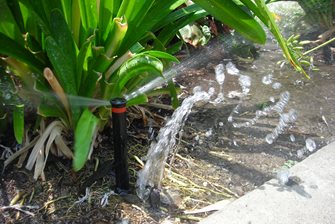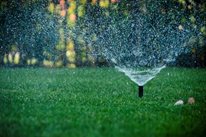Sprinkler System Repair and Maintenance
Seasonal care and tips from the pros
While sprinkler systems are relatively low-maintenance, they do need periodic servicing and repair to continue working effectively. Leaks, breaks, and seasonal maintenance are part of the territory even with perfectly-installed systems. As a homeowner, it’s hard to know what you can do yourself and when it’s better to call a pro. Here, landscaping professionals weigh in on what’s involved with sprinkler system maintenance.
Common repair needs and solutionsSprinkler heads. “Sprinkler heads have a lot of small moving parts, and as with anything mechanical, they will eventually fail,” says Jeremy Walla of Aspen Ridge Lawn and Landscape in Rapid City, SD. Sediment can clog them, and the heads can get smashed or broken in the course of everyday life.
Troubleshooting a Sprinkler System
Get professional tips for fixing a residential sprinkler system from Scott Cohen of The Green Scene in Northridge, Calif. Learn how to reduce overspray, address leaks, and more.
However, you may not need to call a professional to repair a broken or clogged head. “If you’re handy,” Walla says, “you can ask your landscaper to supply you with a few of the heads used within your system so you’ll have them at the ready in case of problems.” You simply dig out around the broken head, unscrew it, and screw in the new one, being careful not to get any soil inside the system.
Valve leaks. If your valve begins to leak, it’s likely you need a new one. Since valves connect to both electricity and water, this is definitely a task for a licensed landscape contractor.
Broken pipe. While it’s tough to break a high-quality PVC pipe with a shovel, it’s possible that someday you’ll experience a broken pipe. Because fixing a broken pipe usually requires a lot of digging as well as some special tools, this is usually best left to professionals. Repairing a broken PVC pipe first requires special cutters or a fine saw to cut away the broken section. Then you’ll need primer, glue, and a slip fitting to piece it together again.
Did you know that sprinkler pipes are not really glued together, but welded instead? PVC pipes are actually welded together using a solvent, explains Scott Cohen of The Green Scene in Northridge, CA. A "solvent" is a material which causes a partial dissolving of PVC pipe and fittings so that a chemical fusion occurs between the pipe and fitting. Apply solvent to both sides of the parts you want to connect, then push the fittings tightly together. The solvent will melt the parts together and fuse them into one. Be sure the points of connection are clean and sanded free of burs before welding together.
The danger of repairing broken pipes is that if soil gets into the system, it could clog or damage the sprinkler heads. Your landscaper will know how to flush the system as needed to prevent problems. It’s also important to make sure the repaired section isn’t leaking before you cover it up again.
Of course, you should keep in mind that even if you can repair something without the help of a pro, it’s often best to call your landscaper for an appointment anyway. As Rick Evans of Aesthetic Gardens in Mountain View, CA points out, “By the time your system needs repair, it also likely needs an on-site review of the entire system to make sure everything’s in good working order. Most homeowners just don’t have the time for that.”
Seasonal care for your irrigation systemWinterizing. In mild climates, the only winter adjustment you’ll need to make is to turn the timer off when the winter rains begin. If you have your timer hooked up to a water sensor, you may not even need to do that. However, people in cold climates need to take special steps to ensure that a hard freeze doesn’t burst or damage sprinkler pipes, heads or valves.
“We hook up an air compressor to the irrigation system and blow out all of the water before the first freeze, so when the ground freezes, no water is left in the pipes,” says Walla. “Where I live, the frost line is 48 inches deep. Since irrigation systems are only 12-15 inches deep, you can see why this is so important.” For the same reason, winter blow-outs should also be done on drip irrigation systems in cold climates.
Spring start-ups. Spring is the perfect time to thoroughly check your system before letting it run all season. This spring checkup is a service most landscape contractors offer. It involves checking the spray pattern of all the heads to be sure there’s complete coverage with no runoff, checking for leaks or geysers in the landscape, and generally making sure the watering system is behaving as expected. Some problems only turn up after a few days. Your landscape contractor may come back after the system has been running regularly for a few days so they can look for soggy areas or other indications of a below-ground leak.
Sprinkler systems can save a lot of time in the landscape, and just a little ongoing maintenance and care can go a long way in keeping your system running smoothly for years to come.
Related Reading:Learn how to save water and have a thriving lawn
Find out what factors influence the price of sprinklers
Get an overview of the sprinkler installation process
Return to Sprinkler Systems




 Watering Tips
Watering Tips Sprinkler System Cost
Sprinkler System Cost Sprinkler Installation
Sprinkler Installation

